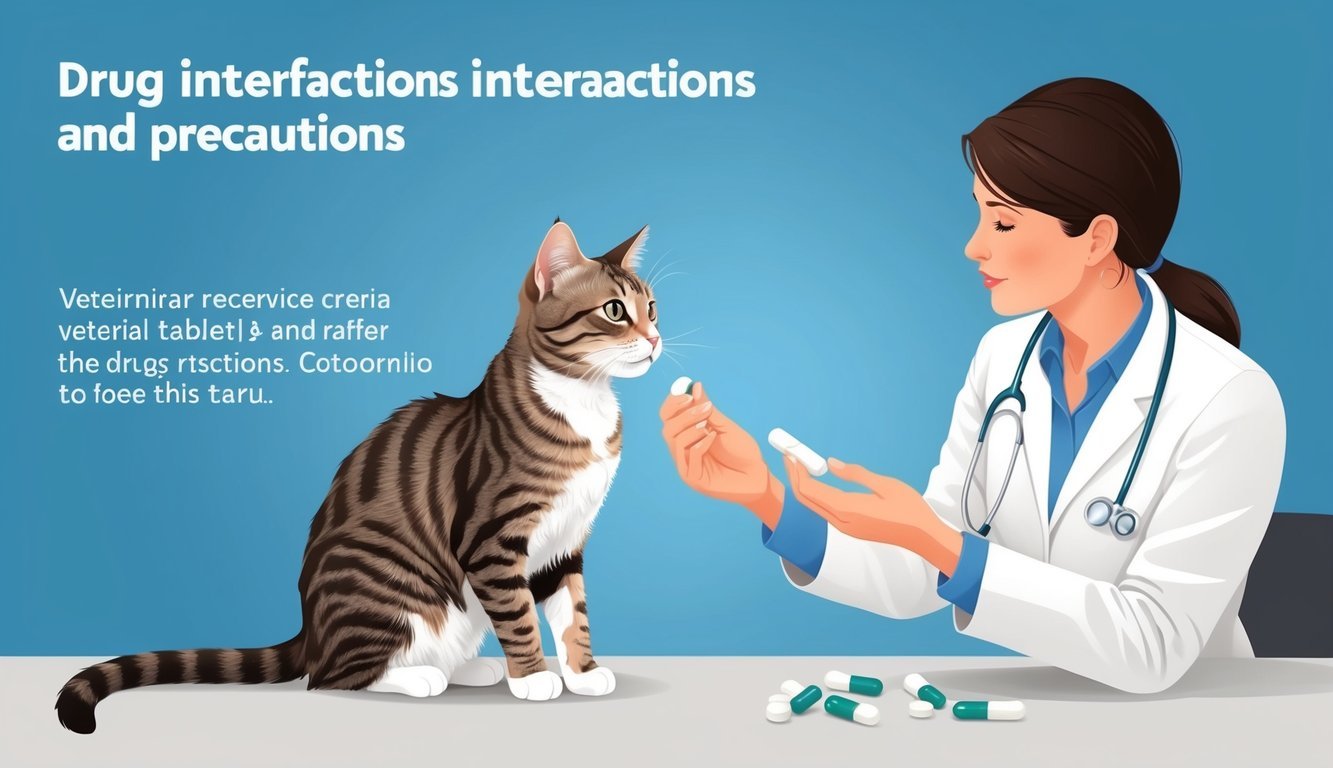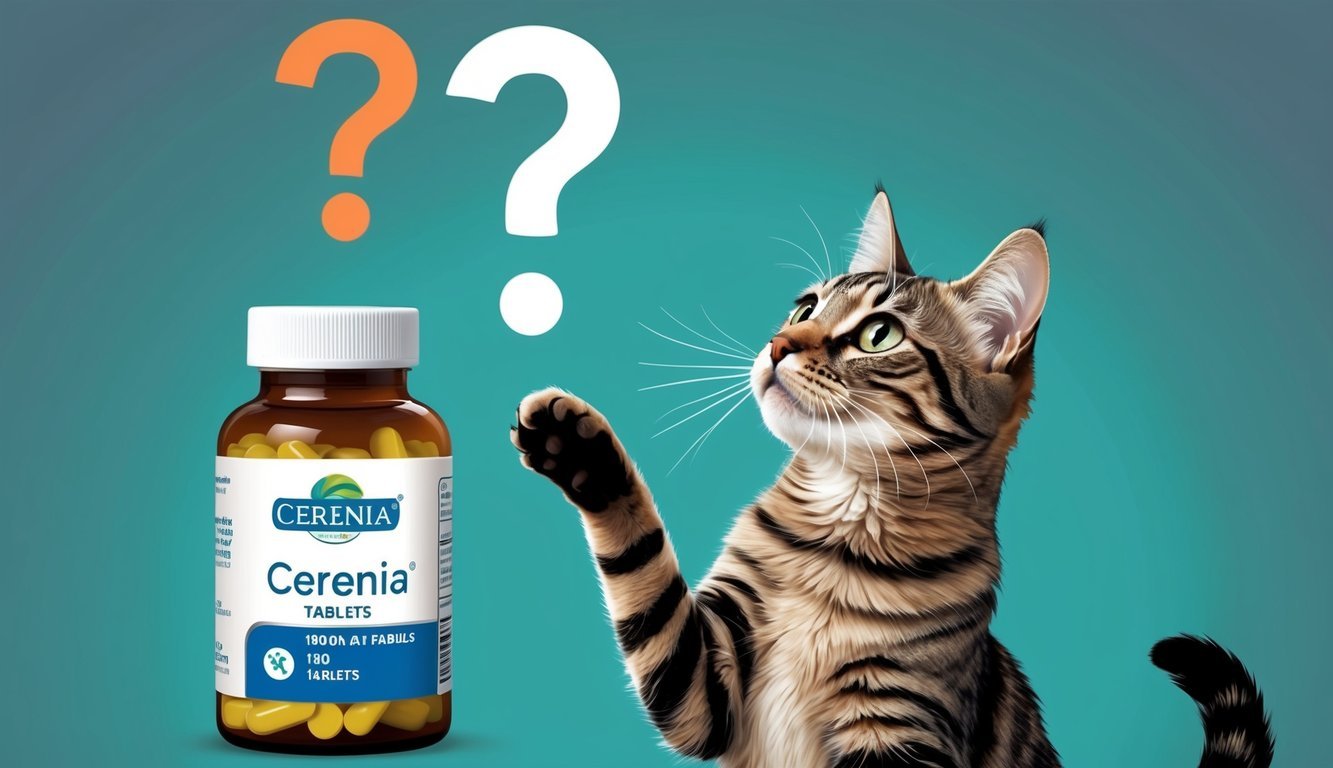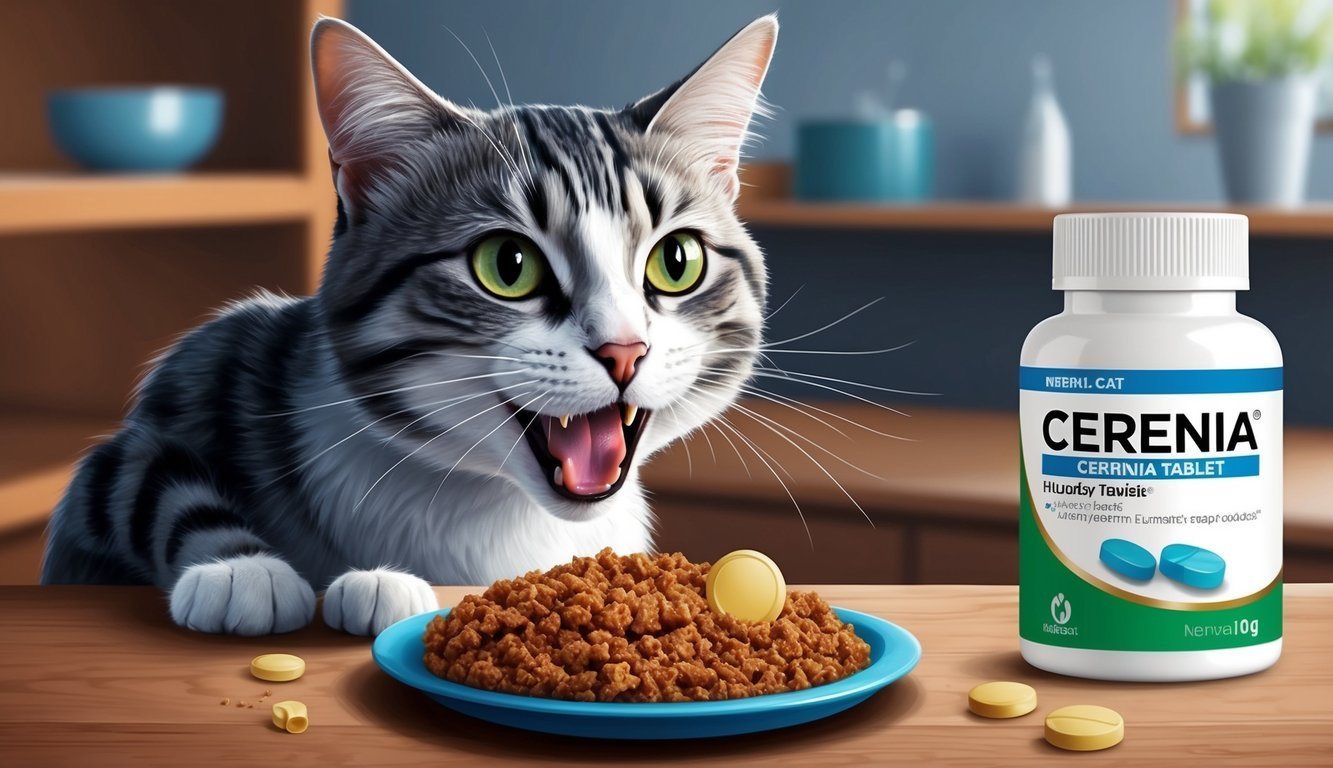Cerenia tablets are a valuable option for managing nausea and vomiting in cats.
They are especially helpful when these conditions arise from various causes like motion sickness or underlying health issues. Although the FDA has not officially approved these tablets for feline use, veterinarians widely prescribe them off-label for their effectiveness. If your cat has been struggling with these symptoms, understanding how Cerenia works and how to safely administer it can make a significant difference in their well-being.
When considering Cerenia for your cat, you’ll want to be aware of the appropriate dosages, potential side effects, and necessary precautions.
While Cerenia is generally safe, monitoring your cat after administration is crucial to ensuring they don’t experience adverse effects.
Knowing when and how to use Cerenia can enhance your pet’s comfort and help you manage their health better.
Before diving deeper into the details, it’s important to recognize that while Cerenia can be a helpful remedy, open communication with your veterinarian about its use is essential for your cat’s safety and health.
Key Takeaways
- Cerenia tablets can treat nausea and vomiting in cats effectively.
- Understanding proper dosages and monitoring is crucial for safety.
- Consult your veterinarian for guidance on using Cerenia for your pet.
Understanding Cerenia and Its Uses
Cerenia is a vital medication for managing vomiting and nausea in cats.
It contains Maropitant Citrate, which effectively addresses these issues, making it an essential tool for your veterinarian.
The Science Behind Cerenia
Cerenia functions primarily as an anti-emetic, which means it helps prevent vomiting.
It targets the central nervous system, particularly influencing the chemoreceptor trigger zone (CRTZ) and vomiting center in the brain.
By blocking “Substance P,” a neuropeptide involved in the vomiting process, Maropitant reduces the urge to vomit.
This medication is FDA approved, ensuring its safety and efficacy when used as directed.
It’s available in both injectable and oral tablet forms, allowing flexibility based on your cat’s needs.
Common reasons for prescribing Cerenia include various triggers like chemotherapy, motion sickness, and post-surgery recovery.
Approved Uses for Cats
Cerenia is particularly effective for managing acute vomiting and nausea caused by different issues.
It’s often used to help cats recovering from surgery or those undergoing chemotherapy, as these situations can lead to significant discomfort.
Dosage depends on your cat’s weight and the condition being treated.
For conditions like motion sickness, a typical initial dose is 1-2 mg/kg given orally.
For acute vomiting, it can go up to 4 mg/kg.
Always consult your veterinarian for precise guidance tailored to your cat’s specific health needs.
This ensures your furry friend receives the most appropriate and effective care.
Administration Guidelines
When administering Cerenia to your cat, understanding the available forms and proper dosages is crucial.
This medication can be given orally or via injection, with specific instructions for each method.
Adhering to veterinarian recommendations will help ensure the safety and effectiveness of the treatment.
Oral and Injectable Options
Cerenia is available in two primary forms: tablet and injectable solution.
The tablets are typically administered orally, either directly or mixed with food, which can be beneficial for cats that are picky eaters.
You can give these tablets with or without food.
For the injectable form, it’s important to consult your veterinarian for instructions on how to administer it properly.
Unlike the tablets, the injectable solution is generally used for more urgent situations, like severe vomiting.
Your vet can provide guidance on the best option based on your cat’s specific needs.
Determining the Correct Dosage
The dosage of Cerenia varies based on your cat’s weight and the form you are using.
For instance, the recommended oral dosage is 1-2 mg/kg (0.45-0.9 mg/lb) of body weight, and this should be administered once daily.
If you opt for the injectable form, the recommended dose is 0.1 mL/kg (0.046 ml/lb) once daily for up to five days.
Always check with your veterinarian to ensure you’re giving the correct dosage.
They will help calculate the exact dose based on your cat’s weight and specific condition.
Potential Side Effects and Risks
When considering Cerenia tablets for your cat, it’s essential to be aware of the potential side effects and risks.
While many cats tolerate the medication well, some may experience adverse reactions.
Understanding these can help you monitor your pet effectively.
Common Adverse Reactions
Common side effects of Cerenia include lethargy, diarrhea, and loss of appetite.
These occurrences are typically mild and may resolve on their own as your cat adjusts to the medication.
Some cats may also experience hypersalivation, where excessive drooling can occur.
Always observe your cat during treatment to identify any unusual behavior or symptoms.
If the side effects persist or worsen, contacting your veterinarian is crucial.
This ensures that your cat’s needs are addressed promptly and appropriately.
Serious Concerns and Allergies
While uncommon, serious allergic reactions can occur.
Symptoms to watch for include intense itching, swelling, or difficulty breathing.
If you notice any of these signs, seek emergency veterinary help immediately.
Injection site reactions are also possible.
Your cat may show signs of pain, swelling, or redness where the injection was given.
Monitoring this area helps ensure your cat’s comfort and safety.
Dehydration may arise due to increased vomiting or diarrhea.
Keep an eye on your cat’s water intake and overall behavior.
If dehydration is suspected, consult your veterinarian without delay.
Drug Interactions and Precautions

When considering Cerenia for your cat, it’s essential to understand potential drug interactions and any special precautions.
Certain medications can affect how Cerenia works, while specific health conditions may also influence its safety and efficacy.
Medications to Avoid
Several medications can interact negatively with Cerenia.
Here are some key ones to be cautious about:
-
Chloramphenicol: This antibiotic can increase Cerenia levels in the bloodstream. Monitor your cat closely if these two are prescribed together.
-
Erythromycin and Itraconazole: These can also elevate Cerenia’s concentration. Be aware of this if your cat needs any of these treatments concurrently.
-
Ketoconazole: This antifungal can affect the metabolism of Cerenia, leading to possible side effects.
-
Nonsteroidal Anti-Inflammatory Drugs (NSAIDs): Combining NSAIDs with Cerenia can heighten the risk of gastrointestinal issues. Consult your vet before administering them together.
-
Phenobarbital: If your cat is on this anticonvulsant, consider close monitoring as it may affect how your cat metabolizes Cerenia.
Always inform your veterinarian about any medications your cat is currently taking.
Special Considerations
In addition to drug interactions, certain health conditions warrant caution when using Cerenia.
If your cat is pregnant or nursing, discuss Cerenia’s risks and benefits thoroughly.
While it’s generally considered safe, individual circumstances can vary.
For cats with kidney or liver disease, Cerenia should be used cautiously.
These conditions can impair drug metabolism and elimination, leading to possible toxicity.
Always keep your vet informed about your cat’s health history.
This knowledge helps tailor the best treatment plan, ensuring your furry friend’s safety while managing their nausea or vomiting.
Cerenia in Multicat Households and with Other Pets

In multicat households, managing medications like Cerenia requires careful consideration.
Understanding how Cerenia interacts with other pets, particularly cats and dogs, is crucial for their well-being.
Interactions with Other Cats
When administering Cerenia to one cat in a multi-cat environment, it’s essential to monitor how the other cats respond.
Some cats may exhibit curiosity or stress when another cat is being treated.
Keep your treated cat isolated initially to ensure they don’t feel threatened or bullied during their recovery.
Cerenia itself doesn’t typically induce aggressive behavior; however, each cat’s personality plays a role.
If your cats tend to engage in playful or territorial disputes, it may be wise to separate them during the treatment period.
When administering Cerenia, it’s imperative to ensure each cat receives the correct dosage without inadvertently allowing another cat to ingest the medication.
Use in Dogs and Comparative Aspects
Cerenia is approved for use in dogs as well, providing a comparative aspect when considering its administration in a household with both cats and dogs.
The dosage for dogs differs and must be prescribed based on their weight and condition.
Both species can safely use Cerenia, but side effects might vary.
Dogs might be more tolerant to certain doses, while cats are more sensitive.
If you have dogs and cats, ensure that Cerenia is administered only to the intended pet, and consult with your veterinarian if both types of animals are present.
Veterinarians often suggest developing a schedule or a medication chart to track when each pet receives their medication.
This can help prevent accidental overdoses and ensure that every pet is treated properly.
Monitoring and Follow-up

Monitoring your cat’s response to Cerenia is crucial for ensuring the medication is effectively managing their nausea and vomiting.
Regular follow-ups will help track any side effects or changes in your cat’s condition, allowing for timely adjustments.
Assessing Treatment Efficacy
After starting Cerenia, keep a close eye on your cat’s behavior.
Are they eating normally?
Observe any changes in appetite, as anorexia can indicate that the treatment isn’t working effectively.
Record the frequency of vomiting.
If your cat continues to vomit or shows chronic symptoms, it may require an evaluation from your veterinarian.
It can be helpful to maintain a medication log.
Note the date and time you administered Cerenia and any observed side effects.
This information will assist your veterinarian in determining if the current dosage is appropriate or if further laboratory tests are necessary.
Testing may be crucial if underlying issues, like inflammatory bowel disease or cancer, are suspected.
When to Seek Further Veterinary Care
If your cat experiences severe reactions or shows concerning symptoms after starting Cerenia, contact your veterinarian immediately.
Symptoms such as excessive vomiting, diarrhea, or lethargy that persists can indicate a need for further evaluation.
Regular veterinary follow-ups are essential, especially if your cat has a history of gastrointestinal issues like gastroenteritis or chronic vomiting.
If symptoms do not improve within a few days, additional tests may be necessary.
Ultimately, your veterinarian can recommend the best course of action, whether that’s adjusting medication or exploring other treatment options.
Understanding Overdose Risks and Emergency Care

Being aware of potential overdose risks is crucial when administering Cerenia to your cat.
Understanding how to identify the signs of an overdose and knowing the steps to take in an emergency can help you act swiftly and effectively.
Identifying Overdose
An overdose of Cerenia can lead to serious health issues in your cat.
Signs of toxicity may include:
- Severe vomiting
- Lethargy
- Loss of appetite
- Diarrhea
- Disorientation
If you notice any of these symptoms, it’s vital to assess the situation immediately.
Cerenia is typically prescribed at 1 mg/kg, so be particularly cautious if your cat has received an extra dose or if you have accidentally given a higher amount than recommended.
Recognizing these signs early can be the difference between a minor issue and a serious emergency.
Immediate Steps and Emergency Treatment
If you suspect your cat has overdosed on Cerenia, prompt action is essential.
First, contact your veterinarian or an emergency animal clinic right away.
Be ready to provide them with details such as the dosage given and the time of administration.
While waiting for assistance, keep your cat calm and monitor them closely.
Offer a comfortable space and avoid giving any food or water until a vet has advised you on the next steps.
Treatment may include intravenous fluids to rehydrate your cat and supportive care to manage symptoms.
Your veterinarian will guide you through specific treatment protocols based on your cat’s condition.
Frequently Asked Questions

When it comes to Cerenia tablets for cats, you might have several questions.
Understanding the right dosage, duration of effect, possible side effects, and other important details can help ensure your cat’s safety and comfort.
What’s the correct dose of Cerenia for my kitty?
The typical dosage can vary based on the specific condition being treated.
For motion sickness, a common dose is 1-2 mg/kg taken orally once daily.
For acute vomiting, it may be increased to 2-4 mg/kg.
Always consult your vet for personalized dosing recommendations.
How long does the effect of Cerenia usually stick around in cats?
Cerenia generally begins to take effect within one hour after administration.
The effects can last for up to 24 hours, depending on your cat’s individual response and the condition being treated.
Are there any side effects I should watch out for after giving my cat Cerenia?
While Cerenia is usually well-tolerated, some cats may experience side effects.
These can include vomiting, lethargy, and diarrhea.
Keep an eye on your kitty after administration, and contact your vet if you notice any concerning symptoms.
Should Cerenia be given to cats on an empty stomach or with food?
Cerenia can be given to cats regardless of whether they have eaten.
However, it’s generally recommended to administer it on an empty stomach if it’s for the treatment of nausea and vomiting, as this can enhance its effectiveness.
Can giving Cerenia to my cat decrease their appetite at all?
Yes, some cats may experience a decrease in appetite after taking Cerenia.
If you notice significant changes in your cat’s eating habits, it’s a good idea to discuss this with your veterinarian.
In the unfortunate event that a cat passes away, how can I tell if it was related to Cerenia?
Determining the cause of a cat’s passing can be complicated.
If your cat’s health declined after starting Cerenia, gather relevant information.
This includes dosage and timing.
Then, consult your veterinarian for a proper evaluation.


